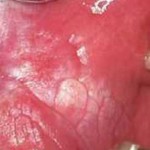
Last week we looked at a review of the malignant transformation rate in oral leukoplakia, the commonest of the oral potentially malignant disorders (OPMDs). As OPMDs can result in pain discomfort and concern regarding the possibility of developing cancer, assessing their impact on patients quality of life is increasingly important. The aim of this review was to assess the literature on quality of life (QoL) in patients with of OPMDs.
Methods
Searches were conducted in PubMed/Medline and CINHAL and limited to English language studies. Two reviewers independently selected studies that assessed QoL using a validated generic or oral health specific instrument in patients with OPMDs. Study quality was assessed. A narrative summary of the findings was presented.
Results
- 14 studies (4 clinical trials, 10 cross sectional) were included.
- 11 studies were conducted in Europe, 2 China, 1 in Iran.
- 13 studies evaluated oral lichen planus (OLP), 1 epidermolysis bullosa.
- 8 of the included studies were considered to be weak and 6 of moderate quality.
- 1 study used the Dermatology Life Quality Index (DLQI) with all the other studies using an oral health related QoL instrument. Of these 11 used the Oral Health Impact Profile (OHIP) and 3 the Chronic Oral Mucosal Disease Questionnaire (COMDQ).
- The findings differ but, overall, do not provide evidence that patients with OPMDs have a poorer QoL compared with healthy patients.
Conclusions
The authors concluded: –
There is no strong evidence that patients with OPMDs have a poorer QoL compared with healthy patients. Several things may explain this superficially surprising conclusion. First, the quality of most of the articles included in this review was moderate or weak; second, most of the studies assessed QoL only in patients with OLP, and these cannot be generalized to all patients with OPMDs; finally, direct comparisons between patients with OPMDs and healthy controls were rarely included. The validity of the QoL instrument used for patients with OLP was frequently inadequate. There is a need for improved and more widely applicable tools in this area of oral medicine.
Comments
The finding that QoL was not affected by OPMDs (leukoplakia, erythroplakia , Palatal lesions in reverse smokers, submucous fibrosis, lichen planus , actinic keratosis , Discoid lupus erythematosus, dyskeratosis congenital, epidermolysis bullosa) is surprising as one would anticipate some impact with these conditions. However, the authors do highlight problems with the quality of the available literature and the fact that studies on only one of the OPMDs, Lichen planus dominated the findings. Consequently, there is clearly a gap in our understanding of the impact on OPMDs on patients’ QoL.
Links
Tadakamadla J, Kumar S, Johnson NW. Quality of life in patients with oral potentially malignant disorders: a systematic review. Oral Surg Oral Med Oral Pathol Oral Radiol. 2015 Jun;119(6):644-55. doi: 10.1016/j.oooo.2015.01.025. Epub 2015 Mar 17. Review. PubMed PMID: 25956217.
Dental Elf – 24th July 2015 – Oral leukoplakia: malignant transformation rate highly variable

Oral potentially malignant disorders have little impact on quality of life? http://t.co/HzRBJfIpG9
Limited evidence suggests OPMDs have little impact on quality of life http://t.co/HzRBJfIpG9
Little quality of life impact for oral potentially malignant disorders? http://t.co/HzRBJfIpG9
Very interesting findings. Hopefully we can do more studies to understand how oral malignant disorders affect one’s quality of life. Thanks for sharing!
Review suggests OMPDs have little impact on quality of life http://t.co/HzRBJfIpG9
Don’t miss- Oral potentially malignant disorders and impact on quality of life http://t.co/HzRBJfIpG9
Review suggests OMPDs have little impact on quality of life http://t.co/QDjeJawYLC via @TheDentalElf